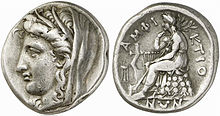Stater
The stater (/ˈsteɪtər/ or /stɑːˈtɛər/;[1] Template:Lang-grc IPA: [statɛ̌ːr], literally "weight") was an ancient coin used in various regions of Greece. The term is also used for similar coins, imitating Greek staters, minted elsewhere in ancient Europe.
History

The stater, as a Greek silver currency, first as ingots, and later as coins, circulated from the 8th century BC to 50 AD. The earliest known stamped stater (having the mark of some authority in the form of a picture or words) is an electrum turtle coin, struck at Aegina[2] that dates about 700 BC.[3] It is on display at the Bibliothèque Nationale of Paris. According to Robin Lane Fox, the stater as a weight unit was borrowed by the Euboean stater weighing 16.8 grams from the Phoenician shekel, which had about the same weight as a stater (7.0 grams) and was also a fiftieth part of a mina.[4]
The silver stater minted at Corinth[5] of 8.6 grams weight was divided into three silver drachmas of 2.9 grams, but was often linked to the Athenian silver didrachm (2 drachma) coin weighing 8.6 grams.[6] In comparison, the Athenian silver tetradrachm was weighing 17.2 grams. Staters were also struck in several Greek city-states such as, Aegina, Aspendos, Delphi, Knossos, Kydonia, many city-states of Ionia, Lampsacus, Megalopolis, Metapontium, Olympia, Phaistos, Poseidonia, Syracuse, Thasos, Thebes and more.

There also existed a "gold stater", but it was only minted in some places, and was mainly an accounting unit worth 20–28 drachms depending on place and time, the Athenian unit being worth 20 drachmas. (The reason being that one gold stater generally weighed roughly 8.5 grams, twice as much as a drachma, while the parity gold: silver, after some variance, was established as 1:10) The use of gold staters in coinage seems mostly of Macedonian origin. The best known types of Greek gold staters are the 28 drachma Kyzikenos from Cyzicus.
Non-Greek staters
Celtic tribes brought the concept to Western and Central Europe after obtaining it while serving as mercenaries in north Greece.[7] Gold staters were minted in Gaul by Gallic chiefs modeled after those of Philip II of Macedonia, which were brought back after serving in his armies, or those of Alexander and his successors.[7] Some of these staters in the form of the Gallo-Belgic series were imported to Britain on a large scale.[8] These went on to influence a range of staters produced in Britain.[9]
Celtic staters were also minted in present-day Czech Republic and Poland.[10] The conquests of Alexander extended Greek culture east, leading to the adoption of staters in Asia. Gold staters have also been found from the ancient region of Gandhara from the time of Kanishka.[11]
Gallery
-
Corinthian stater. Obverse: Pegasus with Qoppa (Ϙ) beneath. Reverse: Athena wearing Corinthian helmet. Qoppa symbolised the archaic writing of the city (Ϙόρινθος).
-
Gold stater of Alexander the Great. Obverse: Athena wearing Corinthian helmet. Reverse: Nike holding stylis and wreath. Possibly minted in Abydos c. 328-323 BC.
-
Stater struck in Velia 334-300 BC, Athena wearing a Phrygian helmet decorated with a Centaur, Lion devouring prey
-
Silver stater of Mithrapata of Lycia, ca. 390–370 BC
See also
References
- ^ Merriam-Webster
- ^ Coin images
- ^ Ancient coinage of Aegina. snible.org. Retrieved on 2011-02-10.
- ^ Lane Fox, Robin. Travelling Heroes: Greeks and Their Myths in the Epic Age of Homer. P. 94. London: Allen Lane, 2008. ISBN 978-0-7139-9980-8
- ^ Smith, William. A Dictionary of Greek and Roman Antiquities. J. Murray, 1881.
- ^ Catalogue of Greek coins, A. Baldwin, Boston, 1955
- ^ a b De Jersey, Philip (1996). Celtic Coinage in Britain. Shire Publications. pp. 1–2. ISBN 0-7478-0325-0.
- ^ De Jersey, Philip (1996). Celtic Coinage in Britain. Shire Publications. pp. 15–19. ISBN 0-7478-0325-0.
- ^ De Jersey, Philip (1996). Celtic Coinage in Britain. Shire Publications. pp. 20–26. ISBN 0-7478-0325-0.
- ^ Żabiński, Zbigniew (1981). Systemy pieniężne na ziemiach polskich. Zakład Narodowy Im. Ossolińskich, PAN. p. 22. ISBN 83-04-00569-7.
- ^ Prabha Ray Himanshu (2006-06-01). Coins in India. Marg Publications. ISBN 978-81-85026-73-2.






